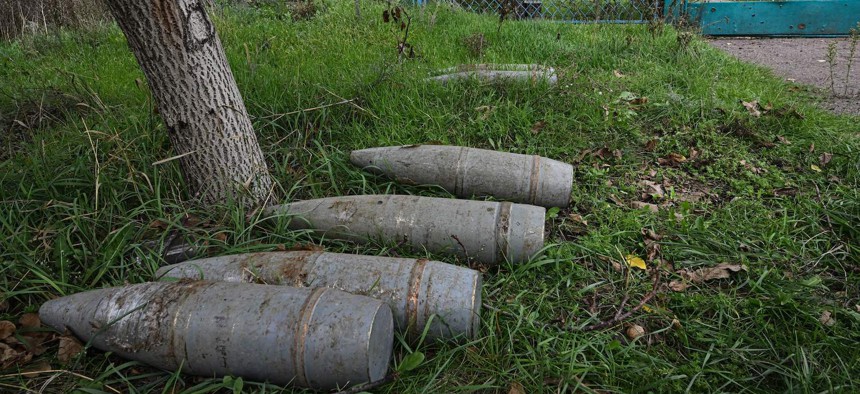
A photograph taken on September 27, 2022, shows artillery shells laid on the ground in the recently liberated village of Vysokopillya, Kherson region. AFP via Getty Images / GENYA SAVILOV
US to Send 18 More HIMARS to Ukraine Under Latest $1B Aid Package
But they won’t be available for two years, Pentagon says.
The United States will provide another $1.1 billion in weapons to Ukraine, the Pentagon announced Wednesday, notably 18 more long-range artillery trucks that will not be ready for two years.
The latest weapons package, briefed to reporters at the Pentagon Wednesday by civilian and military defense officials, comes as Moscow has begun mobilizing as many as 300,000 conscripts to back up weakened infantry forces that have been pushed back across Ukraine, and amid threats by Russian political leaders that they might use nuclear weapons to defend their gains.
The military official also said that the Pentagon did know much yet about leaks reported Monday in the Nord Stream pipeline, which runs under the Baltic Sea to carry natural gas from Russia to Europe. The military official said that the the water where the pipeline is leaking is 80 to 100 meters deep. Some German officials on Wednesday said the pipeline damage was a deliberate attack and blamed Russia.
Wednesday’s announced package brings the total aid provided to Ukraine since Russia invaded in February to $16.9 billion. It includes billions in weapons drawn from existing U.S. stockpiles, and billions in promised systems from western and U.S. defense firms.
The aid package also includes two unmanned aerial system (UAS) radars; 20 multi-mission radars, counter-UAS capabilities; explosive ordnance disposal gear; surveillance systems; almost 350 tactical or uparmored vehicles; body armor; and funds for training, maintenance support and sustainment, the official said.
When asked why the U.S. was not sending the additional HIMARS from existing U.S. stockpiles – which would more than double the number of those artillery systems on the ground, a senior defense official said the plan was to begin preparing for the long-term needs of Ukraine, and put orders in now so they will be ready if the conflict ends.
“If we don't invest today, to procure HIMARS for the future, they won't be there when the Ukrainian armed forces need them down the road,” the senior defense official said. “This is a really sizable investment.”




